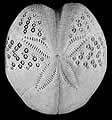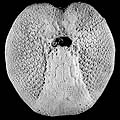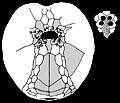The Echinoid Directory
Hemipatagus Desor, 1858, p. 416
[=Tuberaster Peron & Gauthier, 1885, p. 46, type species Tuberaster tuberculatus Peron & Gauthier, 1885; =Chuniola Gagel, 1903, type species Chuniola carolinae Gagel, 1903 ]
| Diagnostic Features |
|
|---|---|
| Distribution | Middle Eocene to Oligocene, ?Miocene, North America, Europe and North Africa. |
| Name gender | masculine |
| Type | Hemipatagus hoffmanni Desor, 1858, p. 416, (=Spatangus hoffmanni Goldfuss, 1826, p. 152), by original designation. |
| Species Included |
|
| Classification and/or Status |
|
| Remarks | Differs from Lovenia only in lacking an internal fasciole and in having more lanceolate petals. In some ways intermediate between Maretia and Lovenia. Chuniola though currently too poorly known to be placed in synonymy with confidence, has an almost identical upper surface. |




